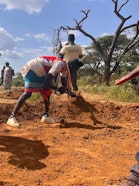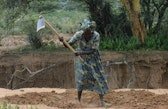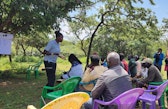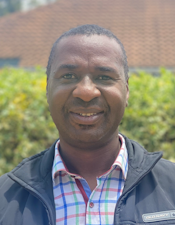Wie die Kachelitwa-Gemeinschaft die Wiederherstellung von Weideland im Baringo County in Kenia vorantreibt
Projektupdate
Veröffentlichungsdatum: 16. Oktober 2025

Multi-purpose corridors and ecosystem restoration
Multi-purpose corridors and ecosystem restorationWie die Kachelitwa-Gemeinschaft die Wiederherstellung von Weideland im Baringo County in Kenia vorantreibt
Projektupdate
Multi-purpose corridors and ecosystem restoration
Multi-purpose corridors and ecosystem restorationVeröffentlichungsdatum: 16. Oktober 2025
- Inhalt
Soweit das Auge reicht, tragen die Hügel von Kachelitwa im Baringo County die Spuren jahrzehntelanger Bodendegradation. Die Region litt jahrzehntelang unter klimawandelbedingten Dürren sowie unter Unsicherheit durch Banditentum und Viehdiebstahl. Einst produktive Weideflächen sind heute karg und erodiert und können die pastoralen Lebensgrundlagen, von denen Generationen lebten, nicht mehr sichern. Obwohl die Sicherheit durch die Regierung weitgehend wiederhergestellt wurde, steht die Gemeinschaft weiterhin vor grossen Herausforderungen.
Anfang 2024 brachten neue Partnerschaften frischen Schwung nach Kachelitwa. Durch die Zusammenarbeit mit der benachbarten Mukutan Conservancy erkannte die Gemeinde Kachelitwa – lange unsicher über ihre Optionen – dass Lösungen für einige ihrer dringendsten Probleme durch gemeinsame Handeln in Reichweite liegen. Mit Unterstützung der Mukutan Conservancy, der Wyss Academy for Nature, Green Earth Warriors und Just Dig It schlossen sich Fachleute der Gemeinde an, um die Schäden an den am stärksten betroffenen Gebieten zu begutachten und praxisnahe, kostengünstige Lösungen zu entwickeln. Ein zehn Hektar grosses Demonstrationsgelände wurde als Testgebiet für Wiederherstellungsmethoden ausgewählt, bevor diese auf die gesamte Landschaft ausgeweitet wurden.


Anschliessend organisierten die Partner eine Schulung, bei der sich Gemeindemitglieder versammelten, um mehr über halbkreisförmige Erdwälle, Gräben und «Gully Healing » (Renaturierung von Erosionsrinnen) zu lernen – einfache, aber wirkungsvolle Techniken, um Regenwasser aufzufangen, Erosion zu stoppen und Vegetation zu regenerieren. Danach ging es direkt auf das Demonstrationsgelände, um ihre neu erworbenen Fähigkeiten anzuwenden. Die Begeisterung war spürbar. «Wir hätten nie gedacht, dass wir unser Land mit so einfachen Methoden verändern könnten», sagte eine Teilnehmerin enthusiastisch, als sie ihren ersten Damm grub.
Was als kleiner Schritt begann, entwickelte sich schnell zu einem gemeinschaftsgetragenen Vorhaben. Eine Gruppe von 35 Frauen, der später fünf Männer beitraten, gründete eine Landschaftsrestaurierungsgruppe, die sich nun dreimal pro Woche trifft, um die Arbeit freiwillig fortzusetzen. Die Gruppe übernahm schnell Verantwortung für die Erdwallarbeiten, wobei mehrere Mitglieder und Gemeindevorsteher betonten: «Das ist unser Projekt – wir tun das nicht für andere, sondern für uns selbst.»



Die Resultate sind sichtbar. Fast 1'000 halbkreisförmige Erdwälle wurden gegraben und das Momentum wächst weiter. «Wir dachten, die Renaturierung sei zu teuer und würde Ressourcen erfordern, die wir nicht haben», erinnert sich der örtliche Häuptling. Nachbargemeinden baten darum von Kachelitwas Erfahrungen zu lernen und lokale Führer bekundeten stolz ihre Unterstützung.
Was als technische Übung begann, ist zu einer Bewegung der Eigenverantwortung und Hoffnung geworden. «Jeder Besuch zur Beurteilung des Fortschritts bestärkt uns erneut», äussert sich Antony Wandera, Programmleiter der Wyss Academy.
«Die Energie ist ansteckend. Wenn dieses Engagment anhält, werden wir nicht nur gesündere Landschaften schaffen, sondern auch wohlhabendere, resilientere Menschen, die in Harmonie mit der Natur leben.»

Mit Blick nach vorne steht die Gemeinschaft erst am Anfang ihres Wiederherstellungsprozesses. Geplant sind Schulungen zum Thema «Mindset change» (Haltungswandel) in Yatta sowie die Integration einkommensschaffender Elemente wie Obstbaumanbau, Honigproduktion und Futterpflanzen in die Wiederherstellungsarbeit. «Das wird helfen, den Landdruck zu verringern, der durch die starke Abhängigkeit von der Viehzucht als Haupteinkommensquelle entsteht», ergänzt Antony.
Mit jedem herausgehobenen Erdwall und Graben, mit jedem gesäten Samen, zeigt die Gemeinschaft von Kachelitwa, wie Wiederherstellung erreichbar und transformativ sein kann, wenn die lokale Gemeinschaft den Prozess leitet. Für die Wyss Academy for Nature zeigt Kachwelita wie Forschung und Praxis zusammengebracht werden können, um gemeinsam Lösungen für die korrelierenden Herausforderungen des Klimawandels, des Biodiversitätsverlusts und der Landbewirtschaftung zu entwickeln.
Team
- ProjektkontaktProjektkontakt
Antony Wandera
Project Manager
